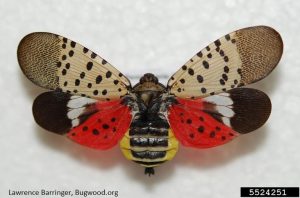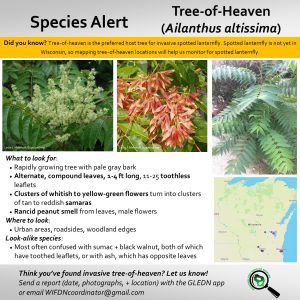Spotted Lanternfly
What is Spotted Lanternfly?
Spotted lanternfly (Lycorma delicatula) is an invasive insect that is spreading throughout the eastern United States. It is a type of planthopper that uses piercing-sucking moutparts to feed on sap from a wide variety of plant species including grapes, maples, and walnuts. It can damage trees from feeding on them (or even kill young trees) and can also promote the growth of sooty mold (a type of fungi) which can kill plants below the tree and cover any items below the tree. Spotted lanternfly is moving westward, though it has not yet been found in Wisconsin.

Read on to learn how you can help with spotted lanternfly monitoring efforts in Wisconsin. Finding this pest as soon as it arrives will give us our best chance at protecting Wisconsin’s trees and woody fruit crops from this pest!
Overview of spotted lanternfly from Wisconsin DATCP
Identification and Impacts of Spotted Lanternfly from UW Insect Diagnostic Lab
Spotted Lanternfly Monitoring with WIFDN
Because spotted lanternfly has not yet been found in Wisconsin, there are two monitoring options that will help us detect this pest when it arrives. The first is to map locations of tree-of-heaven (Ailanthus altissima), an invasive tree that is spotted lanternfly’s preferred host. The second option is to look for spotted lanternfly throughout the growing season.
Tree-of-Heaven Mapping
Tree-of-heaven is an invasive tree that is the primary host for spotted lanternfly. One key step in monitoring for spotted lanternfly is to get an accurate map of tree-of-heaven locations in Wisconsin because it is likely that when spotted lanternfly arrives, we will see it on tree-of-heaven. We have fewer than 50 confirmed locations of tree-of-heaven in the state, though we know there are many, many more! We are also trying to learn how far north tree-of-heaven can survive in Wisconsin.
Identification of Tree-of-Heaven from WIFDN
Want to join tree-of-heaven mapping? Follow these steps:
- Learn how to identify tree-of-heaven and it’s look alike species.
- Go out and look for tree-of-heaven. It is most often found in urban areas and along current and former railroad corridors. Check your local parks and bike paths that are established on old railroad beds!
- If you find tree-of-heaven, send a report to WIFDN so we can add it to the map! Each report should include the date you saw it, photos of the plant(s) you saw, and the location (GPS coordinates). You can email reports to WIFDNcoordinator@gmail.com or use the EDDMapS App or EDDMapS website.

Look for Spotted Lanternfly
Spotted lanternfly is likely to be found first on tree-of-heaven when it arrives in Wisconsin, but it could be found on a variety of other species! That means you can keep an eye out for spotted lanternfly throughout the growing season and report it if you think you’ve found it!
Want to look for spotted lanternfly? Follow these steps:
- Learn how to identify spotted lanternfly in its life stages throughout the year. Watch the video from UW Insect Diagnostic Lab and look at the DATCP fact sheet for reference. Adults will likely be easiest to spot; they typically congregate at tree-of-heaven in late summer (August into October).
- Look for spotted lanternfly! Targeting tree-of-heaven is a good place to start, but looking at other woody plants and trees is also a good idea.
- If you think you’ve found spotted lanternfly, you should report it to the DATCP Spotted Lanternfly Report Form.
Resources
- Spotted lanternfly identification factsheet from DATCP: a good one-page resource that shows pictures of spotted lanternfly’s life stages.
- Tree-of-heaven and look alikes identification guide: a two-page guide to identifying tree-of-heaven and its look alike species in Wisconsin.
- See our 1 page factsheet for a concise look at tree-of-heaven.
- If you are looking to manage tree-of-heaven on your land, or with permission from stakeholders, you can find our recommendations on how to do so on the Renz Weed Science page. We offer a series of control factsheets and you can find Ailanthus altissima aka tree-of-heaven information there.
References:
- Wisconsin Department of Agriculture, Trade and Consumer Protection, Spotted Lanternfly, https://datcp.wi.gov/Pages/Programs_Services/SLF.aspx
- PennState Extension, Spotted Lanternfly, https://extension.psu.edu/spotted-lanternfly




